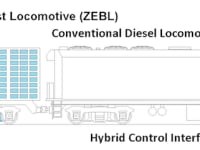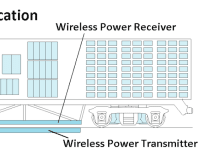Electrified passenger rail is quiet, quick, and clean; BUT the average cost for conversion to electrified rail is over $15 million dollars per route mile for infrastructure and new equipment; and these electric trains are limited in range to the limited electrified track sections.
It is possible to introduce electrification and the corresponding improvements in performance and efficiency to an existing diesel electric regional route incrementally while retaining the versatility and reliability of the conventional diesel electric locomotives? Enter the Zero Emissions Boost Locomotive, ZEBL, a new type of battery locomotive that is simply added into the existing train consist. The ZEBL is not a replacement, it is an enhancement attached behind an existing locomotive and connected with a small interface controller, resulting in a Hybrid Pair. The Hybrid Pair increases acceleration while consuming less fuel and thus reducing emissions relative to the conventional locomotive alone. The ZEBL provides a ‘plug and play’ hybrid solution for existing regional trains making them quicker; allowing them to attain the same or greater average speed as the conventional regional train on a given route with a fraction of the fuel consumed and emissions produced.
The chart graphic illustrates the difference in performance between the current Caltrain regional train going from San Francisco to San Jose and a ZEBL hybridized version of the same train. The red line indicates the conventional train performance with only a diesel locomotive accelerating it and the green line illustrates the hybridized train performance using a single ZEBL. With the improved acceleration rate, the hybrid train has a lower peak speed and spends less time at full throttle on the diesel engine. For the same schedule, the hybridized train will cover the Caltrain route in the same time while consuming almost 50% less energy.
The different technologies that make up the ZEBL and the resulting hybridized train are proven and currently in field service. What is new is the application, interaction and integration of these technologies for regional passenger train hybridization. The ZEBL provides the energy-capture, storage and release capabilities thought to only be available through full electrification and allows them to be applied easily to conventional regional train use.
Inductive power transfer can be easily incorporated on the ZEBL Hybridized train. If a ZEBL equipped regional train and the train stations on its operating route were equipped with a Wireless Power Transfer System (WPTS), the ZEBL could be charged when stopped at each station.
The addition of ZEBLs and WPTS can be accomplished incrementally, train by train and station by station with minimal infrastructure change and no interruption in service. A hybrid train is capable of receiving 90% or more of its energy from the grid, while still having on board fuel storage (CNG or Diesel) for when the electric grid load needs to be reduced during peak demand, long segments where full electric operation is not practical or if the grid goes down during an emergency.
Like this entry?
-
About the Entrant
- Name:David Cook
- Type of entry:teamTeam members:Dave Cook Ian Stewart
- Software used for this entry:Excel
- Patent status:pending





